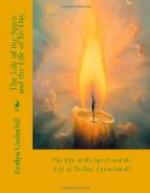Finally, we have to remember that any attempt towards the education of the spirit—and such an attempt must surely be made by all who accept spiritual values as central for life—can only safely be undertaken with full knowledge of its special dangers and difficulties. These dangers and difficulties are connected with the instinctive and intellectual life of the child and the adolescent, who are growing, and growing unevenly, during the whole period of training. They are supple as regards other forces than those which we bring to bear on them; open to suggestion from many different levels of life.
Our greatest difficulty abides in the fact that, as we have seen, a vigorous spiritual life must give scope to the emotions. It is above all the heart rather than the mind which must be won for God. Yet, the greatest care must be exercised to ensure that the appeal to the emotions is free from all possibility of appeal to latent and uncomprehended natural instincts. This peril, to which current psychology gives perhaps too much attention, is nevertheless real. Candid students of religious history are bound to acknowledge the unfortunate part which it has often played in the past. These natural instincts fall into two great classes: those relating to self-preservation and those relating to the preservation of the race. The note of fear, the exaggerated longing for shelter and protection, the childish attitude of mere clinging dependence, fostered by religion of a certain type, are all oblique expressions of the instinct of self-preservation: and the rather feverish devotional moods and exuberant emotional expressions with which we are all familiar have, equally, a natural origin. Our task in the training of young people is to evoke enthusiasm, courage and love, without appealing to either of these sources of excitement. Generally speaking, it is safe to say that for this reason all sentimental and many anthropomorphic religious ideas are bad for lads and girls. These have, indeed, no part in that austere yet ardent love of God which inspires the real spiritual life.
Our aim ought to be, to teach and impress the reality of Spirit, its regnancy in human life, whilst the mind is alert and supple: and so to teach and impress it, that it is woven into the stuff of the mental and moral life and cannot seriously be injured by the hostile criticisms of the rationalist. Remember, that the prime object of education is the moulding of the unconscious and instinctive nature, the home of habit. If we can give this the desired tendency and tone of feeling, we can trust the rational mind to find good reasons with which to reinforce its attitudes and preferences. So it is not so much the specific belief, as the whole spiritual attitude to existence which we seek to affirm; and this will be done on the whole more effectively by the generalized suggestions which come to the pupil from his own surroundings, and the lives of those whom he admires, than by the




